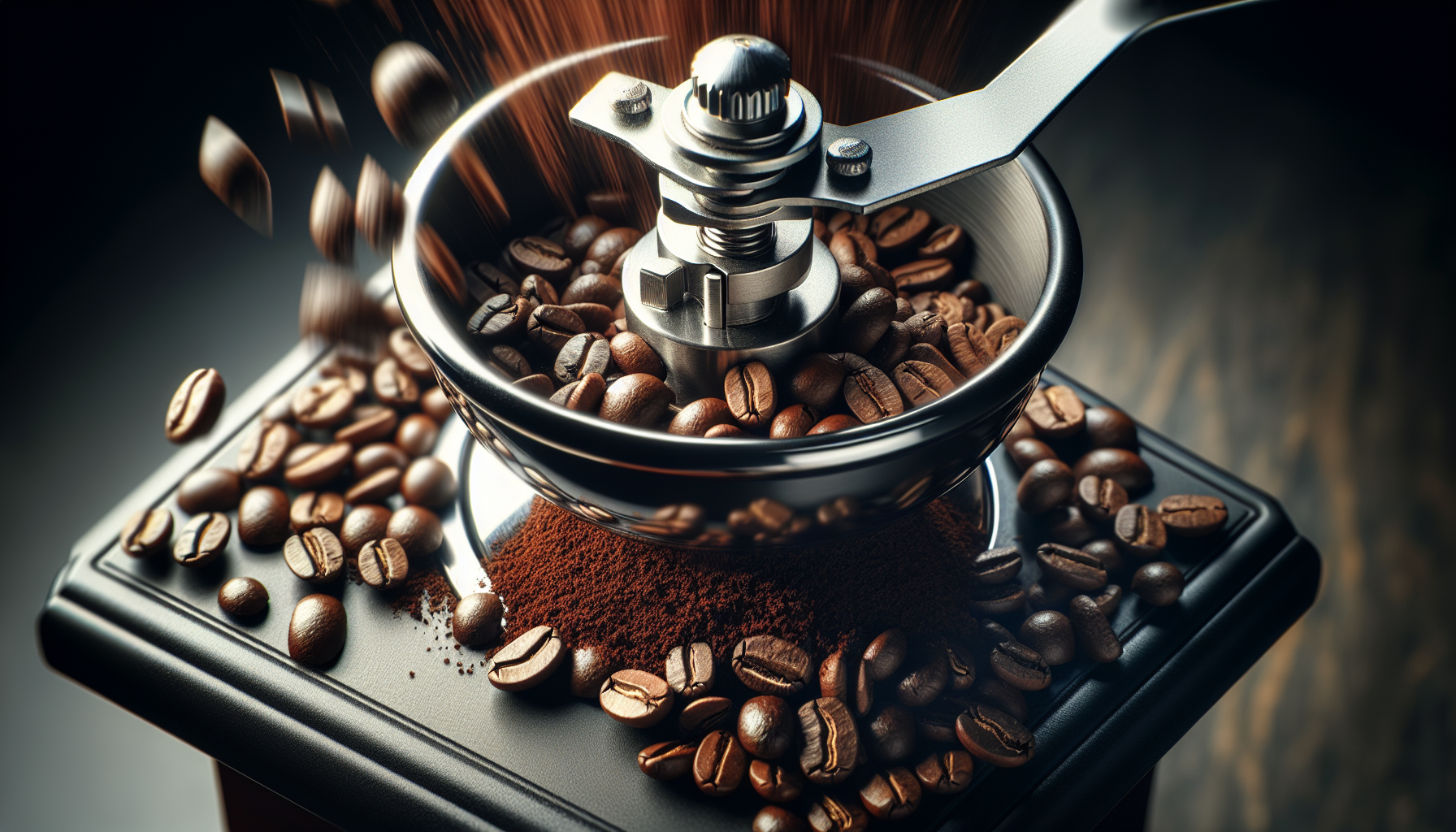If you’ve ever found yourself staring at a bag of coffee beans with the daunting task of choosing the right grind for your regular coffee maker, you’re not alone. With so many options out there, it’s easy to feel overwhelmed. But fear not, because we’re here to guide you through the world of coffee grinds. Whether you prefer a bold and flavorful cup or a smoother, more subtle brew, we’ll help you find the perfect grind to elevate your morning routine. So grab a mug and let’s dive into the wonderful world of coffee grinding!
CHECK OUT COFFEE GRINDERS ON AMAZON
Coarse Grind
What is a coarse grind?
A coarse grind refers to coffee beans that have been ground into larger particles. These particles are similar in size to sea salt or coarse sand. The texture of a coarse grind is rough, and the coffee grounds have a more noticeable texture.
Why is a coarse grind best for a regular coffee maker?
A coarse grind is best for a regular coffee maker because it allows for a slower extraction process. When water comes into contact with the larger coffee particles, it takes longer for the water to extract the flavors from the beans. This slow extraction process results in a milder and less intense cup of coffee, which is preferable for many coffee drinkers.
How to achieve a coarse grind
To achieve a coarse grind, you can use a coffee grinder and adjust the settings to a coarse setting. Alternatively, certain coffee grinders have specific grind settings for coarse grinds. Simply set the grinder to the coarse setting, add the desired amount of coffee beans, and let the grinder do its work. Once ground, the coarse coffee grounds are ready to be used in a regular coffee maker.
CHECK OUT COFFEE GRINDERS ON AMAZON
Medium Coarse Grind
What is a medium coarse grind?
A medium coarse grind falls between a coarse grind and a medium grind. The coffee particles are slightly smaller than those in a coarse grind but still retain a noticeable texture. They are larger than a medium grind and are similar in size to breadcrumbs.
Why is a medium coarse grind suitable for a regular coffee maker?
A medium coarse grind is suitable for a regular coffee maker because it strikes a balance between a milder and a more intense cup of coffee. The slightly smaller coffee particles allow for a faster extraction process compared to a coarse grind. This results in a cup of coffee that is bolder and more full-bodied, while still maintaining a pleasant balance of flavors.
How to achieve a medium coarse grind
To achieve a medium coarse grind, you can adjust the settings on your coffee grinder to a medium coarse setting. If your coffee grinder does not have specific settings, you can aim for a grind size that is slightly larger than breadcrumbs. Experimentation and adjusting the grinder settings accordingly will help you achieve the desired medium coarse grind for your regular coffee maker.
Medium Grind
What is a medium grind?
A medium grind refers to coffee beans that have been ground into particles that are slightly smaller than those in a medium coarse grind. The texture of the coffee grounds is similar to regular sand.
Why is a medium grind suitable for a regular coffee maker?
A medium grind is suitable for a regular coffee maker because it facilitates a faster extraction process. The smaller coffee particles increase the surface area in contact with water, allowing the water to extract the flavors more efficiently. This results in a well-balanced cup of coffee with a good amount of flavor and body.
How to achieve a medium grind
To achieve a medium grind, you can adjust the settings on your coffee grinder to a medium setting. If your coffee grinder does not have specific settings, you can aim for a grind size that is slightly smaller than regular sand. Once the coffee beans are ground to the desired medium grind, they are ready to be used in a regular coffee maker.
Medium Fine Grind
What is a medium fine grind?
A medium fine grind consists of coffee particles that are slightly smaller than those in a medium grind. The texture of the coffee grounds is finer and smoother, similar to granulated sugar.
Why is a medium fine grind suitable for a regular coffee maker?
A medium fine grind is suitable for a regular coffee maker because it produces a cup of coffee that is more intense and flavorful than the previous grind sizes mentioned. The smaller coffee particles allow for a faster extraction process, resulting in a brew that is rich in flavor, aroma, and body.
How to achieve a medium fine grind
To achieve a medium fine grind, you can adjust the settings on your coffee grinder to a medium fine setting. If your coffee grinder does not have specific settings, you can aim for a grind size that is slightly smaller than granulated sugar. Once the coffee beans are ground to the desired medium fine grind, they are ready to be used in a regular coffee maker.
Fine Grind
What is a fine grind?
A fine grind consists of coffee particles that are smaller than the previous grind sizes mentioned. The texture of the coffee grounds is smooth and similar to powdered sugar.
Why is a fine grind not recommended for a regular coffee maker?
A fine grind is not recommended for a regular coffee maker because it can lead to over-extraction. The small coffee particles allow for a very fast extraction process, resulting in a cup of coffee that can be bitter and overpowering. Fine grinds are more commonly used in espresso machines or other brewing methods that require shorter extraction times.
How to achieve a fine grind
To achieve a fine grind, you can adjust the settings on your coffee grinder to a fine setting. If your coffee grinder does not have specific settings, you can aim for a grind size that is similar to powdered sugar. However, it is important to note that a fine grind is not recommended for a regular coffee maker, so it is advisable to avoid this grind size for optimal brewing results.
Extra Fine Grind
What is an extra fine grind?
An extra fine grind consists of coffee particles that are even smaller than those in a fine grind. The texture of the coffee grounds is extremely fine, similar to flour.
Why is an extra fine grind not recommended for a regular coffee maker?
An extra fine grind is not recommended for a regular coffee maker because it can result in a cup of coffee that is bitter and unpleasant. The extremely fine coffee particles allow for rapid extraction, leading to a brew that is over-extracted and can taste burnt or astringent. Extra fine grinds are commonly used in Turkish coffee or certain espresso brewing methods.
How to achieve an extra fine grind
To achieve an extra fine grind, you can adjust the settings on your coffee grinder to an extra fine setting. If your coffee grinder does not have specific settings, you can aim for a grind size that is similar to flour. However, it is important to note that an extra fine grind is not recommended for a regular coffee maker. It is best to use this grind size for specific brewing methods that call for it.
Blade Grinders vs. Burr Grinders
What are blade grinders?
Blade grinders are coffee grinders that consist of a spinning blade that chops the coffee beans into smaller pieces. These grinders are usually more affordable and readily available in most households.
What are burr grinders?
Burr grinders are coffee grinders that use two revolving abrasive surfaces, called burrs, to grind coffee beans. These surfaces crush the coffee beans into consistent and uniform particles. Burr grinders are generally more expensive but offer greater precision and control over the grind size.
Which type of grinder is best for a regular coffee maker?
For a regular coffee maker, a burr grinder is recommended over a blade grinder. Burr grinders produce more consistent coffee particles, resulting in a better extraction and a more flavorful cup of coffee. The precise control over the grind size also allows for customization based on personal taste preferences.
Tips for using blade and burr grinders
When using a blade grinder, it is important to pulse the grinder rather than continuously grind to achieve a more consistent grind size. With burr grinders, it is advisable to experiment with different grind settings to find the perfect size for your regular coffee maker. Additionally, regularly cleaning and maintaining the grinder will ensure optimal performance and longevity.
Pre-ground Coffee vs. Freshly Ground Coffee
What is pre-ground coffee?
Pre-ground coffee refers to coffee that has been ground and packaged before it reaches the consumer. This coffee is typically found in supermarkets or coffee shops and comes in various grind sizes based on the intended brewing method.
What is freshly ground coffee?
Freshly ground coffee refers to coffee beans that are ground just before brewing. This ensures that the coffee is as fresh as possible and retains the maximum flavor and aroma.
Which type of coffee is best for a regular coffee maker?
Freshly ground coffee is best for a regular coffee maker. By grinding the coffee beans just before brewing, you can ensure that the coffee is at its peak freshness and flavor. Pre-ground coffee, although convenient, may have already lost some of its flavor and aroma during storage.
Benefits of using freshly ground coffee
Using freshly ground coffee allows you to experience the full depth of flavor and aroma that coffee beans have to offer. The oils and volatile compounds present in coffee beans degrade over time, so grinding them just before brewing ensures that these qualities are preserved. Freshly ground coffee can elevate your cup of coffee to a whole new level of enjoyment.
Factors to Consider When Choosing the Grind Size
Coffee maker type
Different coffee makers require different grind sizes. Coarse grinds are best suited for regular coffee makers, while finer grinds are typically used for espresso machines or other specialized brewing methods.
Brewing method
The brewing method you choose will also determine the ideal grind size. Pour-over methods, such as the Hario V60, generally require a medium grind, while French press brewing calls for a coarser grind to prevent sediment in the cup.
Personal taste preferences
Your personal taste preferences play a significant role in choosing the right grind size. Experimentation is key to finding the perfect balance of flavors, body, and aroma that suits your palate. Adjusting the grind size can enhance or mellow the natural characteristics of coffee.
Using a coffee grinder
Investing in a coffee grinder gives you greater control over the grind size. Electric burr grinders are recommended for their precision and consistency. Manual burr grinders are a more affordable option, albeit with a bit more effort required. Regardless of the type, a coffee grinder is a crucial tool for achieving the desired grind size.
Conclusion
Choosing the right grind size for your regular coffee maker is essential for achieving the perfect cup of coffee. Coarse grinds result in a milder flavor, while finer grinds yield bolder and more intense brews. The choice between blade and burr grinders ultimately comes down to personal preference and budget. However, burr grinders offer greater precision and consistency. Opting for freshly ground coffee over pre-ground ensures that your coffee is at its peak freshness and flavor. Consider factors such as coffee maker type, brewing method, personal taste preferences, and the use of a coffee grinder to fine-tune your brewing experience. With the right grind size and fresh beans, you can savor a cup of coffee that is tailored to your liking.

